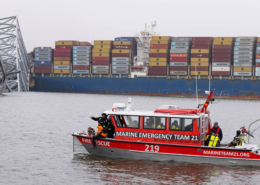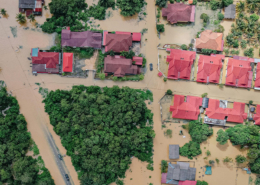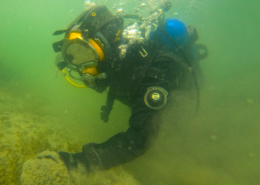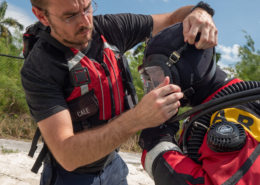It’s a Crime Scene – Until You Rule it Out
By: Wes Foster
Even though public safety agencies operate in different geographical areas across the country, and we use different modes of transportation to get from one place to another. In our travels, we come across bridges traversing bodies of water. Some of these locations may be elevated enough to attract suicidal parties – leading to what we refer to as “bridge jumpers.”
In our public safety positions, it is our responsibility to respond to locations where a call for service is requested.
As we have learned throughout our training, and our careers, we do not get to pick the day, time, or location for these calls for service. In law enforcement, one of our priorities in responding to these calls is determining if a crime has occurred, and if so we must secure the scene so that evidence of a crime can be collected to possibly be used for court purposes at a later date and time.
When a call for service involving a bridge jumper is received, the person threatening to jump, or one that has already jumped, is our immediate focus. But we must be cognizant of the fact that several other possible crime scenes are actually part of the bigger picture. The entire team must be focused on this fact so that all of these other locations are taken into account and secured as rapidly as possible to ensure the evidence is secured.
What determines if it’s a crime scene?
While we all have different responsibilities at the scene, the question that is routinely asked is “what determines if it’s a crime scene.”While there are many different legal opinions and definitions according to the jurisdiction and type of call you’re working, the United Nations Office on Drugs and Crime defines “crime scene” as “[a]ny physical scene, anywhere, that may provide potential evidence to an investigator. It may include a person’s body, any type of building, vehicles, places in the open air or objects found at those locations. ‘Crime scene examination’ therefore refers to an examination where forensic or scientific techniques are used to preserve and gather physical evidence of a crime.”
The vast majority of public safety dive teams are not working on a full time, around the clock schedule. In reality, most public safety dive teams respond on a volunteer basis or work in a position that rescue or recovery is a concurrent assignment to our standard assigned positions. The time required for these teams to respond can be greatly affected and leads us to determine if this will be a rescue or a recovery mission. We have talked about the OSHA requirements relating to 29 CFR 1910 Subpart T on several occasions. In the public safety realm, there are many thoughts on whether or not we must comply with these regulations. As separate ERDI blog post on these standards can be found at https://www.tdisdi.com/public-safety-diving-and-osha-are-we-exempt-final-answer/.
Upon formal notification that assistance is requested, we must understand that the initial request time has most likely already been extended due to the time for approval and will also be affected by travel requirements to reach the scene. All of the available information should be taken into account to determine if this will be a rescue or a recovery and all applicable regulations and standards applied to ensure proper safety precautions are complied with.
Upon arrival, we must ensure all possible crime scenes are secured. Questions we must ask ourselves include things such as: Were there any witnesses? If so, were they secured in separate areas to ensure they could give independent statements? How did the victim arrive? Is there a vehicle involved? Where was the victim last seen? What was the physical and clothing description of the victim? If the victim entered the water, where were they last seen? We must ensure we ask the proper questions, without leading the witness, to narrow down our search area and determine the proper response to the situation. We must start with open ended questions, then narrow them down to more specific questions so we are able to obtain the most accurate information possible. These questions may result in multiple crime scene locations such as a residence, a vehicle utilized to travel to the scene, the location of the actual jump, the entry point, and the underwater area surrounding the jump.
Once we are able to determine a search area, it’s time to plan and begin the search.
While performing the initial search for victims, ensure that the team searches any surrounding ground and bridge support features for the victim. While this may seem strange, some victims have been located in the protective barriers that surround the typical support systems. Many times these barriers are designed to prevent waterborne vessels from coming into contact with the actual support. Victims can become entrapped between the walls and the support structure. If the support structure is protected by objects such as large boulders, be sure to check in the spacing between the boulders as victims sometimes do not actually enter the water. If your team is encountering overhead environments or confined spaces on these searches, do not overreach and exceed your training or equipment limitations. Seek out additional training and certifications from an ERDI Instructor that may be requested or required in your area prior to undertaking these types of searches.
Some important considerations to take into account when responding to the scene are evidentiary recovery and jurisdictional matters.
Jurisdictions are sometimes separated by bodies of water. Upon arrival, responders must determine primary jurisdiction. In our particular area, the initial responders may be from the Sheriff’s Office, local municipal law enforcement agencies, state agencies, or the US Coast Guard. This does not include the fire/rescue or EMS agencies that are responding for any type of medical assistance that may be necessary.
While the jump from the bridge may occur in one jurisdiction, the recovery may take place in a concurrent or totally separate jurisdiction. Each of these jurisdictions must be notified of the incident so that the proper response procedures are followed. We must work together to properly resolve the incident and maintain the evidentiary value for proper follow-up as required.
Depending on the height of the bridge, death may occur instantly.
The impact when the body hits the water is major. Injuries sustained are mainly internal and can result in injuries such as damaged or detached internal organs and broken bones. If the individual does not die instantly, they are usually rendered unconscious or incapacitated to the point they cannot swim to safety which results in drowning. Injuries sustained by bridge jumpers can sometimes be difficult to determine if it was caused by impact, or if they were the result of another crime, such as blunt trauma caused by assault and battery possibly involving a weapon. The Coroner or Medical Examiner must examine the body to determine the cause of death. These will most likely fall into broad categories such as accidental or intentional (self-inflicted or caused by another party).
There is a great article in a previous ERDI blog post on the hydrology of currents and what PSD divers should know that can be found here https://www.tdisdi.com/hydrology-of-currents-ps-divers-should-know/. If the water under the bridge is flowing, additional search areas downstream must be taken into consideration. If the bridge happens to be in a coastal region, tidal flows must also contribute to this search. In coastal areas, the tidal flow changes direction and flow rates several times per day. This could significantly increase the distance the body could have traveled before it submerged and possibly rested on the bottom surface. Even after coming to rest after the incident, the bodily changes that occur after submersion may cause the location to change and eventually surface in another location. Once again, primary jurisdiction of these secondary locations must be looked at.
NFPA 1670 references preplanning responses to repetitive incidents such as bridge jumpers. In many cases, even after an underwater search, a recovery of the body may not occur immediately. If there are multiple incidents of bridge jumpers at the same location, or even other bridge locations in your jurisdiction, your agency should review previous incidents and attempt to determine where subsequent recoveries may form any predictable patterns. Review the previous incidents for the past several years and research the tidal flows at the time of the jump. Next, review the locations the body was eventually recovered and determine how long before the recovery was made and how far the body travelled. Eventually, based on previous incidents, you may be able to determine areas to patrol after a reported incident and recover the body and any associated evidence in an expedient manner.
Evidentiary recovery is usually performed by law enforcement.
For a team with the proper training and certifications, and working in conjunction with the primary agency having jurisdiction, there are generally no prohibitions for a team recovering evidence. It would be a recommendation that team members be certified in court testimony. ERDI offers an eLearning Course on Testifying in Court. Additional information on that course can be found at https://www.tdisdi.com/elearning-courses/testifying-in-court-awareness/.
One more item to consider is an intentional act to stage a suicide scene.
What I am referencing may include acts such as a citizen locating personal items placed on a bridge to make it look as if someone most likely jumped from a bridge, even though no such act actually occurred. Recently, a juvenile in upstate SC was seen walking on a roadway on the way to school. In the immediate vicinity where the juvenile was observed, there was a bridge that crossed a waterway. Shortly thereafter, a citizen observed the juvenile’s backpack lying midway across the bridge against the railing, but the juvenile was not in sight. Law enforcement was notified and immediately responded and a search began shortly thereafter. During a subsequent search of the area, an item belonging to the juvenile was located in the water below. This resulted in additional personnel responding to search the waterway while the ground search continued. Later that day, the juvenile was located safe and sound in a separate location. The investigation revealed that the juvenile intentionally placed the backpack on the bridge and threw the item in the waterway in order to mislead others that a suicide had occurred. While this is the type of situation we train to respond to, significant resources were utilized and diverted from other duties. Even in these types of incidents, we must respond and secure these scenes for any potential evidence – until we can definitively prove no crime occurred. The dive team with primary jurisdiction in that area responded, secured the scene, interviewed the witnesses, and performed the search in the proper manner until the juvenile was safely located. At this point, it must be mentioned that the team had been trained and certified through the ERDI curriculum.
In ERD 1 and additional ERDI courses, there are multiple sections that cover material such as responding to the scene, executing the dive, and post-dive procedures. For more information on these courses, I recommend you contact your local ERDI training facility or an ERDI Instructor for more information.


 Photo By: Defense Visual Information Distribution Service
Photo By: Defense Visual Information Distribution Service


 Y. ZIN
Y. ZIN


Tinggalkan Maklum Balas Anda
Ingin Berbincang Bersama?Kami Hargai Sumbagan Anda!